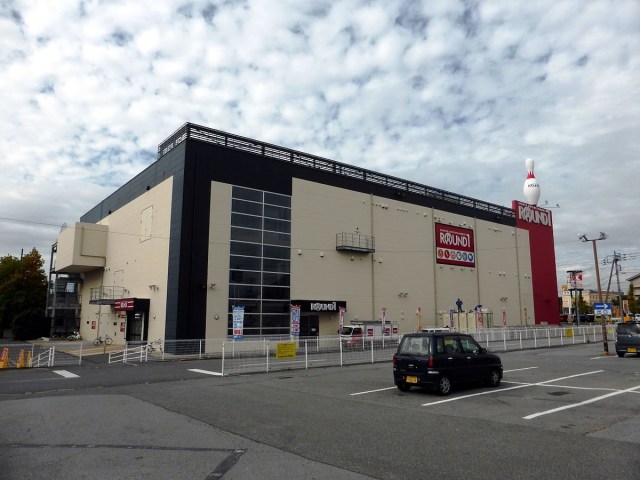
Your eye isn’t the only thing they’re supposed to catch.
Bowling alleys are incredibly easy to find in Japan. That’s not to say that they’re all over the place, but if there is one in your vicinity, you’ll often be able to spot it right away, since there’s a good chance it’ll have a giant bowling pin on top.
This style of exterior is especially prevalent at Round 1. The entertainment center chain’s branches usually also have attached video game arcades, karaoke boxes, and billiards and darts areas, but it’s a bowling pin that’s on the roof of roughly 70 percent of Japan’s 99 Round 1 locations. Obviously the pin functions as an advertisement, but it’s not just meant to catch eyes. It turns out that a lot of those pins are there to catch lightning too.
Under Japanese building codes, a building that’s more than 20 meters (65.6 feet) tall needs to have a lightning rod at its highest point. 20 meters would be about the sixth floor of an apartment building, and with the higher interior ceilings of a commercial-use building like Round 1, getting past 20 meters is pretty easy, especially if there are other tenants in the building too. So for those Round 1 locations that are over 20 meters tall and have a bowling pin on their roof, the tip of the pin has a lightning rod protruding from it.
The protrusion isn’t always noticeable from ground level, but Round 1’s brand management department recently confirmed the lightning rod functionality of its rooftop pins. There is, however, a bit of a chicken-and-egg thing going on here. Ordinarily, if a building is under 20 meters tall, it’s OK without a lightning rod. However, even if the main structure itself is under that limit, if there are antennas, advertisements, or other things attached to the building that stretch more than 20 meters above the ground, then the lightning rod requirement kicks in. So it’s possible that in addition to Round 1 branches that already needed a lightning rod and so built it into the rooftop pin, there may also be branches at which it’s the pin itself that puts them past 20 meters. Either way, though, those pins aren’t just ads, but often safety features too.
Source: J-Town Net via Livedoor News via Otakomu
Top image: Wikipedia/Mr.W
● Want to hear about SoraNews24’s latest articles as soon as they’re published? Follow us on Facebook and Twitter!

 Japanese schoolgirl seeking crowdfunding, art submissions to produce anti-train groper pins
Japanese schoolgirl seeking crowdfunding, art submissions to produce anti-train groper pins The Animate anime lucky bag is an otaku mind-blowing value【Photos】
The Animate anime lucky bag is an otaku mind-blowing value【Photos】 The most unusual ATM in Japan? Banking with yokai spirits who want to know your PIN
The most unusual ATM in Japan? Banking with yokai spirits who want to know your PIN Lightning storm photos of the Skytree show the Tokyo symbol in a whole new light【Photos】
Lightning storm photos of the Skytree show the Tokyo symbol in a whole new light【Photos】 We made a 98-foot-long string telephone at our Japanese countryside house, but does it work?
We made a 98-foot-long string telephone at our Japanese countryside house, but does it work? Foreigner’s request for help in Tokyo makes us sad for the state of society
Foreigner’s request for help in Tokyo makes us sad for the state of society Japanese city loses residents’ personal data, which was on paper being transported on a windy day
Japanese city loses residents’ personal data, which was on paper being transported on a windy day Harajuku Station’s beautiful old wooden building is set to return, with a new complex around it
Harajuku Station’s beautiful old wooden building is set to return, with a new complex around it Osaka governor suggests lowering voting age to 0 to curb population decline
Osaka governor suggests lowering voting age to 0 to curb population decline Ghibli Park now selling “Grilled Frogs” from food cart in Valley of Witches
Ghibli Park now selling “Grilled Frogs” from food cart in Valley of Witches Red light district sushi restaurant in Tokyo shows us just how wrong we were about it
Red light district sushi restaurant in Tokyo shows us just how wrong we were about it Historical figures get manga makeovers from artists of Spy x Family, My Hero Academia and more
Historical figures get manga makeovers from artists of Spy x Family, My Hero Academia and more Suntory x Super Mario collaboration creates a clever way to transform into Mario【Videos】
Suntory x Super Mario collaboration creates a clever way to transform into Mario【Videos】 Smash Bros. director Sakurai stabs Kirby in the face, has delicious justification for it
Smash Bros. director Sakurai stabs Kirby in the face, has delicious justification for it Singaporeans are getting creative when it comes to combating the low fertility rate
Singaporeans are getting creative when it comes to combating the low fertility rate McDonald’s new Happy Meals offer up cute and practical Sanrio lifestyle goods
McDonald’s new Happy Meals offer up cute and practical Sanrio lifestyle goods Japanese ramen restaurants under pressure from new yen banknotes
Japanese ramen restaurants under pressure from new yen banknotes French Fries Bread in Tokyo’s Shibuya becomes a hit on social media
French Fries Bread in Tokyo’s Shibuya becomes a hit on social media Studio Ghibli releases new action figures featuring Nausicaä of the Valley of the Wind characters
Studio Ghibli releases new action figures featuring Nausicaä of the Valley of the Wind characters New private rooms on Tokaido Shinkansen change the way we travel from Tokyo to Kyoto
New private rooms on Tokaido Shinkansen change the way we travel from Tokyo to Kyoto Tokyo Tsukiji fish market site to be redeveloped with 50,000-seat stadium, hotel, shopping center
Tokyo Tsukiji fish market site to be redeveloped with 50,000-seat stadium, hotel, shopping center All-you-can-drink Starbucks and amazing views part of Tokyo’s new 170 meter-high sky lounge
All-you-can-drink Starbucks and amazing views part of Tokyo’s new 170 meter-high sky lounge Beautiful Ghibli sealing wax kits let you create accessories and elegant letter decorations【Pics】
Beautiful Ghibli sealing wax kits let you create accessories and elegant letter decorations【Pics】 Studio Ghibli releases Kiki’s Delivery Service chocolate cake pouches in Japan
Studio Ghibli releases Kiki’s Delivery Service chocolate cake pouches in Japan New definition of “Japanese whiskey” goes into effect to prevent fakes from fooling overseas buyers
New definition of “Japanese whiskey” goes into effect to prevent fakes from fooling overseas buyers Our Japanese reporter visits Costco in the U.S., finds super American and very Japanese things
Our Japanese reporter visits Costco in the U.S., finds super American and very Japanese things Studio Ghibli unveils Mother’s Day gift set that captures the love in My Neighbour Totoro
Studio Ghibli unveils Mother’s Day gift set that captures the love in My Neighbour Totoro More foreign tourists than ever before in history visited Japan last month
More foreign tourists than ever before in history visited Japan last month New Pokémon cakes let you eat your way through Pikachu and all the Eevee evolutions
New Pokémon cakes let you eat your way through Pikachu and all the Eevee evolutions Sales of Japan’s most convenient train ticket/shopping payment cards suspended indefinitely
Sales of Japan’s most convenient train ticket/shopping payment cards suspended indefinitely Sold-out Studio Ghibli desktop humidifiers are back so Totoro can help you through the dry season
Sold-out Studio Ghibli desktop humidifiers are back so Totoro can help you through the dry season Japanese government to make first change to romanization spelling rules since the 1950s
Japanese government to make first change to romanization spelling rules since the 1950s Ghibli founders Toshio Suzuki and Hayao Miyazaki contribute to Japanese whisky Totoro label design
Ghibli founders Toshio Suzuki and Hayao Miyazaki contribute to Japanese whisky Totoro label design Doraemon found buried at sea as scene from 1993 anime becomes real life【Photos】
Doraemon found buried at sea as scene from 1993 anime becomes real life【Photos】 Tokyo’s most famous Starbucks is closed
Tokyo’s most famous Starbucks is closed One Piece characters’ nationalities revealed, but fans have mixed opinions
One Piece characters’ nationalities revealed, but fans have mixed opinions We asked a Uniqlo employee what four things we should buy and their suggestions didn’t disappoint
We asked a Uniqlo employee what four things we should buy and their suggestions didn’t disappoint Princesses, fruits, and blacksmiths: Study reveals the 30 most unusual family names in Japan
Princesses, fruits, and blacksmiths: Study reveals the 30 most unusual family names in Japan Full-size Evangelion statue appears at Japanese theme park with entry plug synchronization tests
Full-size Evangelion statue appears at Japanese theme park with entry plug synchronization tests How to rob an idol singer otaku: Look up the birthday of his favorite idol
How to rob an idol singer otaku: Look up the birthday of his favorite idol Massive storm lights up Tokyo with thousands of lightning strikes 【Pics & Videos】
Massive storm lights up Tokyo with thousands of lightning strikes 【Pics & Videos】 Living Christmas tree starts “Uber Illumination” service from Tokyo
Living Christmas tree starts “Uber Illumination” service from Tokyo Make your own Japanese manju snacks with hotcake mix【SoraKitchen】
Make your own Japanese manju snacks with hotcake mix【SoraKitchen】 Hello Kitty teams up with Indian action movie RRR for RRR x Sanrio Characters merch line and shop
Hello Kitty teams up with Indian action movie RRR for RRR x Sanrio Characters merch line and shop My Neighbor Totoro tie pins and neckties are ready to be presents for your father (or yourself)
My Neighbor Totoro tie pins and neckties are ready to be presents for your father (or yourself) The new Simose Art Museum in Hiroshima houses a floating, futuristic surprise next to the sea
The new Simose Art Museum in Hiroshima houses a floating, futuristic surprise next to the sea Saying “Pocky” found to make better smiles than other smile words like “cheese” and “spaghetti”
Saying “Pocky” found to make better smiles than other smile words like “cheese” and “spaghetti” China’s “paper building” looks like it would topple over if we pushed hard enough
China’s “paper building” looks like it would topple over if we pushed hard enough Bali style: Is that a penjor or are you just happy to see me?
Bali style: Is that a penjor or are you just happy to see me? Pro illustrators earn shockingly little in Japan, according to Kyoto manga design professor
Pro illustrators earn shockingly little in Japan, according to Kyoto manga design professor Kyoto Animation studio in arson attack found to have been in compliance with all fire codes
Kyoto Animation studio in arson attack found to have been in compliance with all fire codes Swiss watchmaker releases new limited edition Pokémon watch priced at $20,000
Swiss watchmaker releases new limited edition Pokémon watch priced at $20,000 For the not-so-low cost of US$1,300 you can own almost every Pretty Cure collector’s badge set
For the not-so-low cost of US$1,300 you can own almost every Pretty Cure collector’s badge set
Leave a Reply